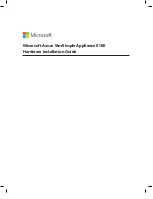
Chapter 9: File System Management
85
Clean Operations
You can set one or both of the
hrs
and
GB-free
options in one command. None of the options
overrides the maximum of 25% total storage cleaned in one operation. With two options set:
•
Whichever option limit the operation reaches first stops the operation.
•
The number of free GB always includes the space available on disk before starting a
clean
operation. For example, a
clean
operation for 100 GBs on a system that already has 50 GB
available on disk will clean only another 50 GB.
•
A
clean
operation asking for
GB-free
that equals or is near the current amount of unused
gigabytes finishes in about two to three hours less time than a more extensive
clean
operation.
•
The
all
option cleans up to the maximum limit of 25% of space on the system.
filesys clean start [
n
hrs |
n
GB-free | all | nowait]
For example, the following command runs the clean operation until 100 gigabytes are available for
data storage. The display includes a warning:
#
filesys clean start 100 GB-free
Are you sure? (yes|no|?) [no]:
Stop Cleaning
To stop the
clean
process, use the
clean stop
operation. Stopping the process during the first
four phases means that all work done so far is lost. Starting the process again means starting over at
the beginning. If the clean process is slowing down the rest of the system, consider using the
filesys clean set throttle
operation to reset the amount of system resources used by
the clean process. The change in the use of system resources takes place immediately.
Administrative users only.
filesys clean stop
Change the Schedule
To change the date and time when
clean
runs automatically, use the
clean set schedule
operation. The default time is Tuesday at 6 a.m. (tue 0600). The operation is available only to
administrative users.
•
A
day
is required with the
weekly
and
monthly
options.
Day
is one or two numerals from
1 to 31 when used with the
monthly
option.
Day
is the first three letters of a day (for
example,
tue
for Tuesday) with the
weekly
option. Use a dash (-) between days for a range of
days. For example:
tue-fri
.
•
A
time
is required, except with the
never
option. 2400 is not a valid time. An entry of
0000
is midnight at the beginning of a day.
Summary of Contents for DD400 Series
Page 1: ...Software Version 3 1 2 DD400 Series Restorer User Guide ...
Page 4: ......
Page 38: ...Regulatory Standards Compliance xxxviii DD400 Series Restorer User Guide ...
Page 54: ...Hardware System Level Interfaces 16 DD400 Series Restorer User Guide ...
Page 60: ...Display the Space Usage Graphs 22 DD400 Series Restorer User Guide ...
Page 96: ...The License Command 58 DD400 Series Restorer User Guide ...
Page 102: ...Return Command Output to a Remote machine 64 DD400 Series Restorer User Guide ...
Page 128: ...Clean Operations 90 DD400 Series Restorer User Guide ...
Page 138: ...Display the History of Disk Failures 100 DD400 Series Restorer User Guide ...
Page 182: ...CIFS Command 144 DD400 Series Restorer User Guide ...
Page 194: ...Procedure Replace a Replica 156 DD400 Series Restorer User Guide ...
Page 210: ...Send Log messages to Another System 172 DD400 Series Restorer User Guide ...
Page 228: ...Operations for Trained Service Personnel 190 DD400 Series Restorer User Guide ...
















































